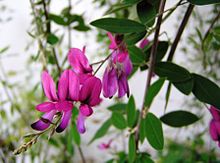Lespedeza
| Lespedeza | |
|---|---|

| |
| Inflorescence and foliage of L. thunbergii | |
| Scientific classification | |
| Kingdom: | |
| (unranked): | |
| (unranked): | |
| (unranked): | |
| Order: | |
| Family: | |
| Subfamily: | |
| Tribe: | |
| Subtribe: | |
| Genus: | Lespedeza |
| Species | |
|
about 40, see text | |
Lespedeza is a genus of some 40 species (including nothospecies) of flowering plants in the pea family (Fabaceae), commonly known as bush clovers or (particularly East Asian species) Japanese clovers (hagi). The genus is native to warm temperate to subtropical regions of eastern North America, eastern and southern Asia and Australasia.
These shrubby plants or trailing vines belong to the "typical" legumes (Faboideae), with the peas and beans, though they are part of another tribe, the Desmodieae. Therein, they are treated as type genus of the smaller subtribe Lespedezinae, which unites the present genus and its presumed closest relatives, Campylotropis and Kummerowia.
Name of the plant
According to American botanist Asa Gray (1810 – 1888), the Lespedeza owes its name to governor of East Florida Vicente Manuel de Céspedes (1784-1790; who, through a letter, allowed to botanist André Michaux explore the East Florida in search of new species of plants, finding there to the Lespedeza[1]), but when Céspedes wrote the letter, at the beginning of it, the name of Céspedes was changed to "Zespedez". So, when the Michaux´s book Flora Boreali-Americana of 1802 was printed, the name "Céspedes" to refer to the plant was written as "Lespedez", word of which derived the current name of the plant.[2][1]
Cultivation and uses
Some species are grown as garden or ornamental plants, and are used as a forage crops, notably in the southern United States, and as a means of soil enrichment and for prevention of erosion. In some areas, certain species are invasive. Lespedeza, like other legumes, have root nodules that harbor bacteria capable of nitrogen fixation from the air into a soil-bound form that can be taken up by other plants. Growers can take advantage of this process by putting the plants in their fields to release nitrogen, so they can use less fertilizer.
L. bicolor leaves and roots contain l-methoxy-N,N-dimethyltryptamine (lespedamin), as well as related Nω,Nω-DMTs and their oxides, as well as some bufotenin.[3]
Species




The species and nothospecies recognized in Lespedeza include:[4]
|
|
The identity and specific validity of L. schindleri is unclear.[5] In addition, there are some species formerly in this genus that are now placed elsewhere, typically in the Lespedezinae, for example, in genus Campylotropis. These include:[6]
- Lespedeza speciosa Schindl. = Campylotropis speciosa (Schindl.) Schindl.
- Lespedeza striata (Thunb.) Hook. & Arn. = Kummerowia striata (Thunb.) Schindl.
- Lespedeza tomentosa Maxim. = Campylotropis pinetorum (Kurz) Schindl.
Footnotes
- ^ a b Lespedeza – From Asia with a Spanish Twist!.
- ^ S. Fralish, James; B. Franklin, Scott (February 2002). Taxonomy and Ecology of Woody Plants in North American Forests: Excluding. Page 568.
- ^ Morimoto & Oshio (1965), Morimoto & Matsumoto (1966)
- ^ ILDIS (2005), and see Wikispecies (26 August 2009) for nothospecies
- ^ ILDIS (2005) contra Wikispecies (26 August 2009)
- ^ ILDIS (2005)
References
![]() Data related to Lespedeza at Wikispecies
Data related to Lespedeza at Wikispecies
- International Legume Database & Information Service (ILDIS) (2005): Genus Lespedeza. Version 10.01, November 2005. Retrieved 2011-FEB-18.
- Morimoto, Hiroshi & Matsumoto, Norichika (1966). Über Alkaloide, VI. Inhaltsstoffe Lespedeza bicolor var. japonica, II. ["Alkaloid contents of L. bicolor var. japonica II."] J. Liebigs Ann. Chem. 682(1): 212–218 [in German]. doi:10.1002/jlac.19666920122
- Morimoto, Hiroshi & Oshio, Haruji (1965). Über Alkaloide, V. Inhaltsstoffe von Lespedeza bicolor var. japonica, I. Über Lespedamin, ein neues Alkaloid. ["Alkaloid contents of L. bicolor var. japonica I. On Lespedamin, a novel alkaloid."] J. Liebigs Ann. Chem. 682(1): 212–218 [in German]. doi:10.1002/jlac.19656820121
External links
- Sericea in conservation farming (Lespedeza cuneata) hosted by the UNT Government Documents Department
- Lespedeza bicolor. USDA NRCS.
